Host: Stacy Schatz
Date: Thursday, 2/6/14
Time: 1:00 - 2:00
Location: Orange ballons
Format: Open discussion with attendees
This was a session that I proposed with the purpose of having attendees share their challenges, insights, techniques, and success stories of managing expectations of stakeholders and executives in their organizations. When introducing this session to the morning group, I mentioned that I certainly don't have all the answers, and was interested in input from others as part of the learnings and insights that all participants, including myself, could take away. Below are photographs of the notes, with some commentary on each.
We started to list some issues and some techniques:
Date: Thursday, 2/6/14
Time: 1:00 - 2:00
Location: Orange ballons
Format: Open discussion with attendees
This was a session that I proposed with the purpose of having attendees share their challenges, insights, techniques, and success stories of managing expectations of stakeholders and executives in their organizations. When introducing this session to the morning group, I mentioned that I certainly don't have all the answers, and was interested in input from others as part of the learnings and insights that all participants, including myself, could take away. Below are photographs of the notes, with some commentary on each.

We started to list some issues and some techniques:

The top three bullet points are issues that some people have faced, and the bottom three were some techniques that were used. Here is some more context for a few that aren't self-explanatory:
• Roadmap Presentation: Some people have done a presentation of the product or business roadmap to stakeholders and execs and mapped that to their iteration plan to show both transparency and how iterative development overlays onto the roadmap.
• Trade-offs: It was noted several times in the discussion that effective management of trade-offs was key and that many issues of misaligned expectations were around this issue. Regular use of a trade-off matrix is key.
• Managing fixed date: This point was related to trade-offs in that it's part of the magic triangle of Scope-Cost-Schedule, so knowing this constraint up-front is important. It is possible to support fixed-date projects in Agile, but the other two aspects of that triangle cannot also be fixed.
More tips and techniques, with bonus spelling errors (mine):

• "Stakeholder death match": One person talked about using this when there was not alignment between stakeholders, such as competing priorities or contradictory requirements. Get the stakeholders together to work it out.
• Prioritization: Not priorization. Sad thing is that I was an English major. Awesome. At any rate, the point was that clear and well communicated prioritization is a must.
• Focus on delivering value: Ultimately your stakeholders (internal and external) just care about getting value for their investment. Keep a focus on that and demonstrate that value can be regularly delivered, and eventually stakeholder buy-in gets easier.
• Someone mentioned that they conduct periodic retrospectives with stakeholders and executives on the results of the team(s)' efforts. It gives those folks a voice to provide feedback and it also puts the focus on results over process.
More tips:
And last few tips from the group:
• Re-examine from time to time: This meant that we need to step back and consider how we're managing expectations at all levels of the organization, and ensure that we're also aligned with the overall business strategy and needs as part of that expectation management.
• "Scoping Team": Erin Kelly and Kitty Parker talked about how they've started to overlay some Lean principles and practices on top of their existing Scrum methods. As part of that their company has created a scoping team of SME's and tech leads that does some initial backlog grooming of sorts to do the initial technical feasibility analysis, dependency identification, high level sizing, and handle the initial "swirl" before the work hits the teams. The individual teams then do their own grooming and sizing, to be clear, but they have found that the use of this scoping team has really helped with managing stakeholder and executive expectations.
• Just-in-time planning: A familiar concept and one that can help reduce swirl and confusion
• Why & What vs. How: This was tying in the point that ensuring that there is the right level of focus at the right level in the organization can aid with managing expectations. Meaning, business owners, stakeholders, and executives should be focused on the Why & What, and let the teams focus on the How. But make sure the teams also know and understand the Why & What.
A final thought that I shared from my own experience, particularly when managing expectations around trade-offs, is to use a metaphor or analogy that has nothing to do with Agile, technology, or business. Such as a house remodel where there is a set budget; when surprises occur, and they almost always do, that often means the schedule gets longer, and something has to come off the list (porcelain tile instead of marble). It's worked for me many times.
Thank you to everyone who attended and all the great discussion!
Sent from my iPhone


No comments:
Post a Comment
Note: Only a member of this blog may post a comment.